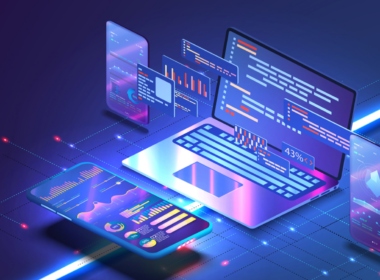“Education isn’t just about memorizing facts—it’s about learning how to think.” That’s what Einstein said, and honestly, he had a point. Traditional education often treats everyone the same, even though we all learn differently. That’s where AI steps in.
AI in eLearning adapts to you. It tracks how you learn, spots weak areas, and adjusts lessons to match your pace. No more struggling through tough topics alone or sitting through stuff you already know. With AI tutors, smart content suggestions, and instant feedback, learning feels smoother and more personal.
And it’s growing fast. The AI in education market was valued at $5.88 billion in 2024 and is projected to grow at a 31.2% CAGR from 2025 to 2030. That means AI-driven learning isn’t just coming—it’s already here. This blog will break down how AI is transforming eLearning and what it means for you.
Level Up Your Learning: How AI is Revolutionizing eLearning Right Now
Ever wonder how your online course really knows what you need? It’s not magic, it’s AI in eLearning, and it’s changing the game. Think of it as having a super-smart study buddy who understands your learning style better than you do. You’re not just passively absorbing information anymore; you’re actively engaging with a personalized learning experience.
Here’s how AI is making waves, with real examples that show you what’s possible:
1. Personalization at Scale:
Imagine walking into a bookstore, and the shelves instantly rearrange to display books you’d love. AI does that for learning. It studies your learning style, progress, and preferences to craft a unique study path. No more wasting time on irrelevant content—everything is tailored to help you grasp concepts faster.
For example, if you’re a visual learner, you’ll see more videos and infographics. If you learn by doing, you’ll get interactive simulations. AI ensures you’re always engaged and learning in the best way for you.
2. Real-Time Progress Tracking:
Imagine having a fitness tracker for your brain—that’s what AI-powered progress tracking is like. AI in eLearning gives you instant feedback, highlighting strengths and areas for improvement, just like a coach who’s always there to guide you.
For example, if you’re taking an online coding course, the AI can track your code in real-time, pointing out errors and suggesting improvements. You’ll know exactly where you stand, and you can make adjustments before it’s too late.
3. Automation of Grading and Assessments:
Let’s be honest, grading papers is a time-consuming task. AI can automate this process, freeing up instructors to focus on what they do best: teaching. This means you get faster feedback on your assignments, allowing you to learn from your mistakes and improve quickly.
For example, AI can automatically grade multiple-choice quizzes, short-answer questions, and even essays. It can analyze your responses, identify patterns, and provide detailed feedback, saving instructors valuable time.
4. Enhanced Student Engagement Through AI Chatbots:
Ever had a question late at night and wished you could ask someone? AI in eLearning makes that possible with chatbots acting as 24/7 tutors. They answer questions, provide support, and even offer encouragement—like a study buddy who’s always there.
For example, if you’re struggling with a concept, you can ask the chatbot for clarification. It can provide explanations, examples, and even links to relevant resources. You’ll never feel lost or alone.
5. Cost-Effective Content Creation:
Creating high-quality educational content can be expensive. AI tools can automate many aspects of content creation, reducing costs and making eLearning more accessible. This means you get more value for your money.
For example, AI can generate quizzes, study guides, and even lesson summaries. It can also translate content into different languages, making it accessible to a wider audience.
6. Scalable Infrastructure for Massive Student Enrollment:
With AI, eLearning platforms can easily handle massive student enrollment. This means you can access high-quality education from anywhere in the world, regardless of your location or background.
For example, Massive Open Online Courses (MOOCs) leverage AI in eLearning to manage thousands of students at once, making global education more inclusive and eliminating barriers to learning.
7. Data-Driven Insights for Curriculum Improvement:
AI can analyze vast amounts of student data to identify trends and patterns. This information can be used to improve the curriculum, making it more effective and relevant.
For example, AI can identify which topics students are struggling with the most. This information can be used to revise the curriculum, providing more support in those areas.
8. Proactive Student Support:
AI can analyze student behavior and performance to identify those at risk of falling behind. This allows instructors to provide proactive support, helping students stay on track and succeed.
For example, if a student’s participation drops, AI in eLearning alerts instructors, enabling timely intervention. This ensures students receive personalized guidance, improving retention rates and learning outcomes while keeping education proactive and effective.
9. Accessibility Enhancements:
AI can make eLearning more accessible to students with disabilities. For example, AI-powered tools can provide real-time captioning for videos, translate text into different languages, and even generate audio descriptions for images.
For example, a student with visual impairment can use a screen reader that is powered by AI to read aloud the text of an online course.
10. Global Learning Communities:
AI can facilitate the creation of global learning communities, connecting students from all over the world. This allows you to collaborate with peers, share ideas, and learn from different perspectives.
For instance, AI-powered translation tools help learners communicate across languages, fostering diverse discussions and idea-sharing. With AI in eLearning, you can engage with global peers, gain new perspectives, and expand your learning beyond borders.
Alright, enough with the “what ifs,” let’s see AI in action with real students and real results.
Real Students, Real AI: See How Learning is Changing Right Now
AI in eLearning is changing the way we learn. Schools and universities around the world use AI to make education more accessible, efficient, and engaging. It’s not just a trend—it’s helping students learn better every day.
1. Harvard’s CS50 Uses AI for Teaching Assistance
Harvard University integrated an AI chatbot called CS50 Duck into its popular CS50 (Intro to Computer Science) course. The AI assistant helps students debug code, answer technical questions, and provide explanations in real time. This has reduced response time for student queries and allowed instructors to focus on more complex teaching tasks instead of repetitive troubleshooting.
2. University of Toronto’s AI-Powered Teaching Assistant
The Rotman School of Management at the University of Toronto developed an AI assistant, All Day TA, which successfully handled 12,000 student queries in one semester. The AI was deployed in about 100 universities worldwide, significantly reducing the workload of human instructors while improving response times for students.
3. AI-Powered Accessibility for Students with Disabilities
Schools in the U.S. have implemented AI tools like speech-to-text converters, real-time captions, and predictive text technologies to help students with dyslexia and other learning disabilities. AI chatbots provide 24/7 learning support, ensuring students can keep pace with their peers without waiting for human assistance.
4. Duolingo – AI-Powered Language Learning
Duolingo is expanding its language offerings and introducing advanced concepts to help over 21 million daily users learn more efficiently. With AI-powered tools, it adapts lessons to your progress, making learning faster and smarter. Large Language Models (LLMs) generate exercises, suggest content, and help experts refine lessons—so you get accurate, engaging, and personalized learning without extra effort.
4. Stanford & Harvard Business Schools Leveraging AI
Stanford MBA student Henry Lu used AI tools to convert readings into podcasts and assist with assignments, enhancing his learning experience. AI allows students to dedicate more time to interactive discussions and complex problem-solving rather than routine tasks. Business schools like Stanford and Harvard now integrate AI into their curricula, helping students—especially career switchers—focus on strategic decision-making rather than technical execution.
6. ChatGPT as a Student Support Tool
Students in Sydney are using ChatGPT to make studying easier. The University of Sydney has even added AI into its curriculum and uses it for grading. To keep things fair, they set ethical rules to prevent misuse. Many students say AI helps them work faster and get instant feedback. But there’s still debate, especially in subjects like humanities, about how much AI should be involved.
Also read: What is Generative AI and How Does it Work in Development?
Okay, so AI is making learning awesome, but like anything new, there are a few bumps in the road we need to talk about!
Navigating the AI Learning: Real Challenges, Real Solutions
Let’s be real, diving into AI in eLearning isn’t always smooth sailing. Like any big change, there are hurdles. But don’t worry, every challenge has a solution, and we’re here to break them down.
Here are some of the key challenges and how you can tackle them:
1. Data Privacy and Security Issues:
With AI analyzing vast amounts of student data, protecting privacy is crucial. You need to ensure data is encrypted and used ethically. Transparency is key; students should know how their data is being used.
To deal with this, implement robust cybersecurity measures and adhere to strict data protection regulations like GDPR or CCPA. Regularly audit your systems and provide clear, concise privacy policies. Partner with platforms that prioritize data security, and use data anonymization techniques whenever possible.
Worried about keeping your learning data safe?
Codewave’s security testing can find and fix weak spots before anyone else does. We’ll make sure your eLearning platform is locked down tight, so you can focus on learning, not security breaches. See our penetration and vulnerability testing services.
2. AI Bias and Fairness in Assessment:
AI in eLearning relies on data-driven algorithms, but if the data is biased, the AI will be too. This can result in unfair assessments and inaccurate learning outcomes. To ensure fairness, it’s essential to refine training data and continuously monitor AI models.
To combat bias, diversify the data used to train AI models and regularly audit algorithms for fairness. Implement feedback loops that allow students and instructors to report potential biases. Use multiple assessment methods to provide a holistic view of student performance, not relying solely on AI-driven evaluations.
3. Human Touch vs. Automated Learning Balance:
While AI can automate many tasks, it can’t replace the human connection. Finding the right balance between automated learning and human interaction is essential for effective education.
To strike the right balance, AI in eLearning can automate repetitive tasks, allowing instructors to focus on mentoring and personalized support. Interactive learning activities can enhance collaboration, ensuring AI enhances—rather than replaces—human interaction in education.
4. Digital Literacy and Accessibility:
Not every student or educator has the same level of digital literacy. Furthermore, many digital tools are not accessible to all. This can create a digital divide.
To address this, provide comprehensive training on digital tools and platforms. Offer multiple learning formats and ensure that all platforms meet accessibility standards such as WCAG. Provide technical support and resources to help students and educators overcome digital literacy challenges.
5. Integration and Implementation Costs:
Implementing AI into existing eLearning systems can be costly and complex. This can be a barrier for many institutions.
To keep costs under control, start with small-scale pilot projects to test and refine solutions. Prioritize tools that deliver the highest impact. AI in eLearning can also leverage cloud-based solutions to minimize infrastructure expenses while maximizing efficiency.
Alright, so we know AI learning has its hurdles, but here’s where we step in to make it smooth.
Codewave: AI-Driven Learning for Maximum Impact
AI is revolutionizing learning by making it more personalized, interactive, and efficient. Codewave builds custom GenAI tools that simplify content creation, boost engagement by 70%, and enhance learning outcomes.
Our AI-driven solutions include:
- Conversational UX: Smart chatbots personalize interactions, improving response accuracy by 40% over time.
- Automation: Intelligent AI tools streamline complex workflows, reducing manual effort by 60%.
- Predictions: AI analyzes patterns and forecasts trends, increasing adaptive learning efficiency by 35%.
- Accuracy: Precision-optimized AI ensures 99% assessment accuracy.
Codewave’s AI solutions are built for agility, ensuring rapid, secure releases and seamless scalability. Our AI-powered platforms auto-scale, handling peak loads 5x more efficiently.
With a proven track record in AI-driven learning solutions, we enable businesses, educators, and enterprises to deliver tailored learning experiences that maximize impact. Let’s redefine learning with AI—connect with us today!
Also, check out our other services here!
What’s Next? Peeking into the Future of AI-Powered Learning
So, where do we go from here? AI in eLearning is evolving rapidly, and the future looks pretty exciting. Imagine a learning experience that’s not just smart, but truly intuitive. Let’s take a look at what’s on the horizon.
Here’s a glimpse into the future trends shaping eLearning:
1. AI-Driven Virtual Classrooms with Real-Time Collaboration Tools:
Picture this: you’re in a virtual classroom that feels just like the real thing, with AI in eLearning enabling seamless collaboration. You can interact with classmates worldwide, share ideas, and work on projects in real time, with AI managing discussions, providing instant feedback, and even translating languages for effortless communication.
2. Personalized Learning Paths Through Deep Learning Algorithms:
Think of deep learning as AI’s super-powered brain. It can analyze vast amounts of data to create hyper-personalized learning paths. This means your education will be tailored to your specific needs and goals, adapting as you progress. You’ll get the right content at the right time, maximizing your learning potential.
3. Predictive Analytics for Lifelong Learning:
AI in eLearning will help you plan your lifelong learning journey. Predictive analytics can identify in-demand skills and recommend relevant courses, keeping you ahead in your career. It can also track your progress and offer personalized guidance to ensure continuous growth.
Stay ahead with data that thinks for you!
Codewave’s predictive intelligence solutions analyze trends, forecast skill demands, and personalize learning paths. Make smarter career moves with AI-driven insights tailored just for you.
4. Voice-Based AI Tutors for Instant Doubt Resolution:
Imagine having a tutor you can talk to anytime, anywhere. Voice-based AI tutors will be able to answer your questions, provide explanations, and offer encouragement, all through natural conversation. This will make learning more accessible and convenient, giving you instant support whenever you need it.
5. Augmented and Virtual Reality (AR/VR) Enhanced Learning:
AI in eLearning will enhance AR/VR experiences, making learning more immersive and interactive. Imagine exploring a virtual anatomy lab or experiencing historical events through simulations. AI will personalize these sessions, ensuring you gain maximum value from every lesson.
Ready to jump into learning that feels real?
Codewave’s XR application development creates immersive learning experiences with AI-powered AR/VR solutions. Engage, interact, and explore like never before—transforming education into a dynamic, hands-on journey.
With AI eLearning, learning never stops.
Wrapping Up
AI in eLearning is making education smarter and more interactive. From personalized lessons to AI-driven content, it’s transforming how we study and teach. Learning isn’t just digital anymore—it’s adaptive, intelligent, and tailored to your needs.
We’ve seen real examples, tackled challenges, and explored what’s next. Now, it’s your turn to be part of this transformation. Want to make learning more engaging and effective? AI can help.
If you’re ready to bring AI into your eLearning platform, Codewave has the tools to make it happen. Let’s take learning to the next level—because the future of education isn’t just digital, it’s intelligent.
Also read: Practical AI Use Cases in Major Industries
Codewave is a UX first design thinking & digital transformation services company, designing & engineering innovative mobile apps, cloud, & edge solutions.







